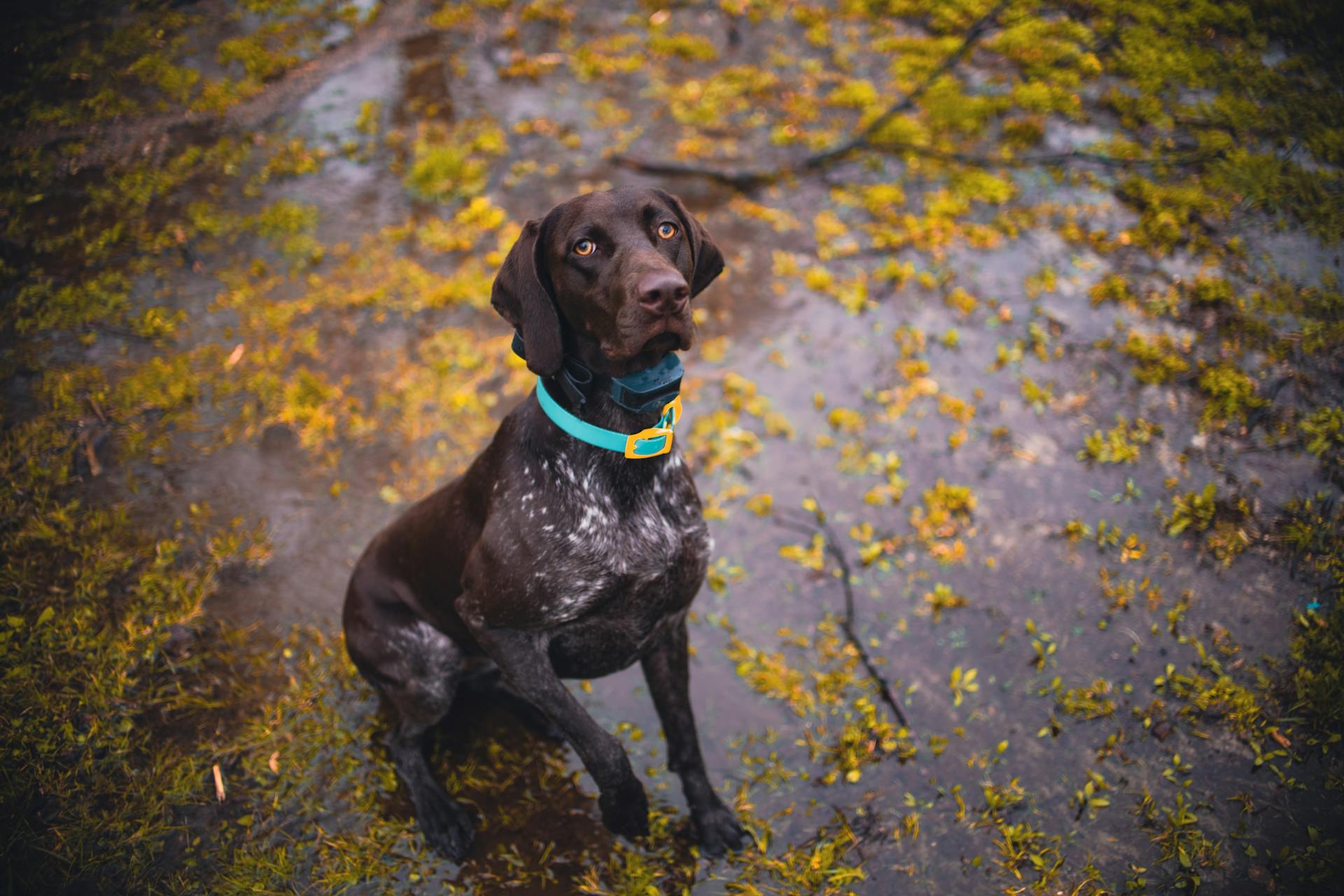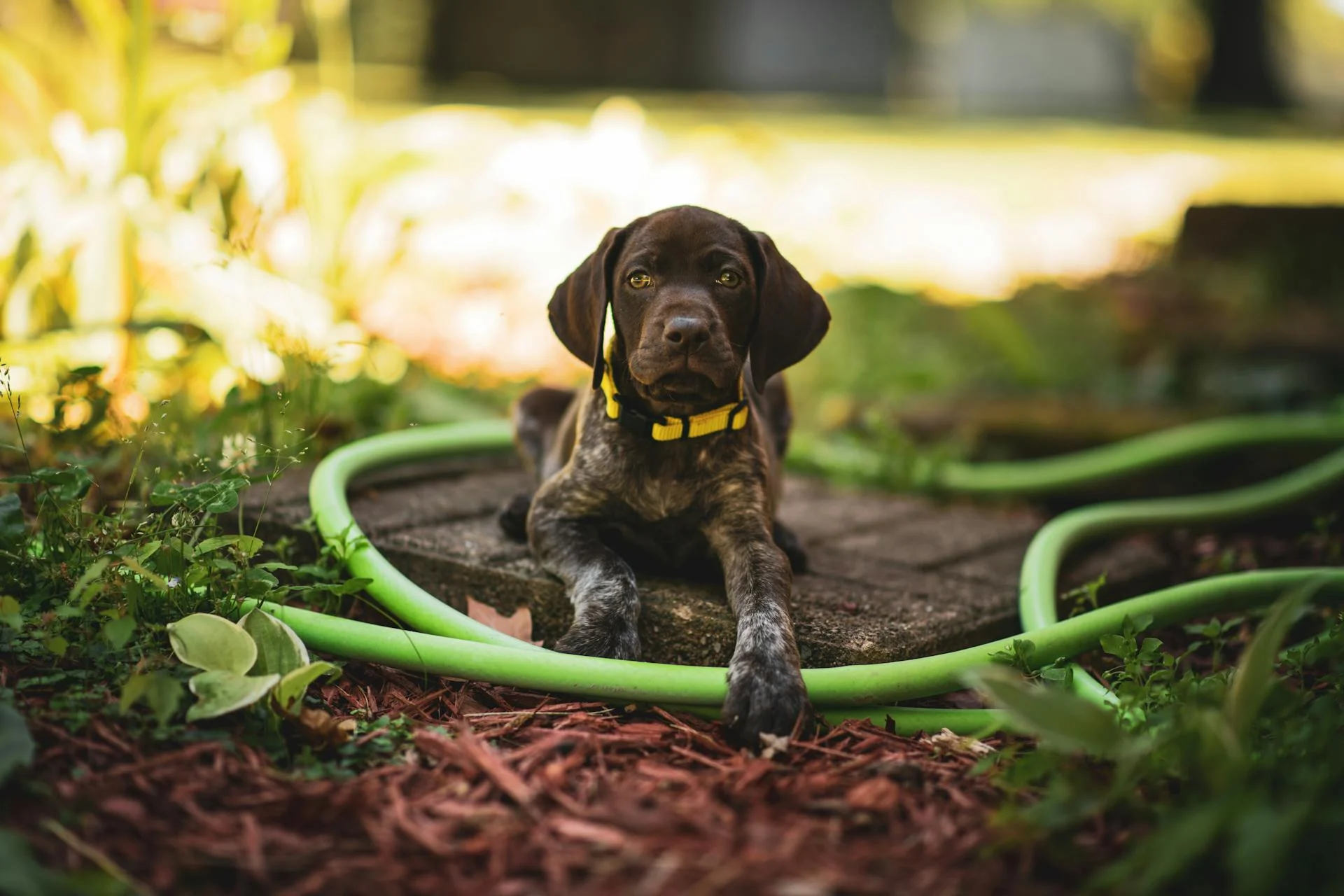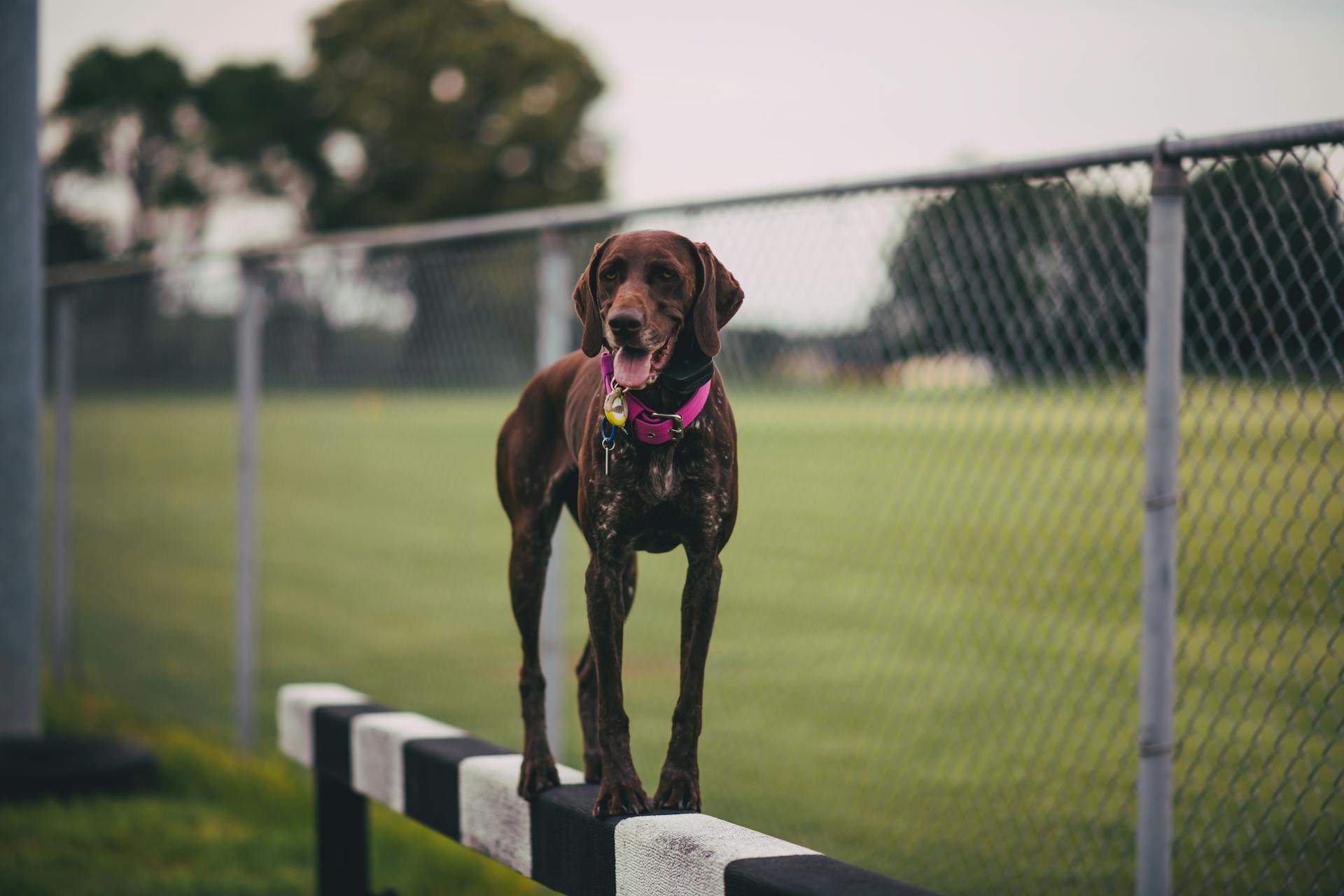
The German Shorthaired Pointer is a versatile hunting breed that originated in Europe, specifically in Germany, in the 19th century. It was bred to be a multi-purpose hunting dog, capable of tracking, pointing, and retrieving game.
One of the breed's earliest uses was for hunting wild boar, which required a dog with a strong prey drive and endurance. German Shorthaired Pointers were bred to thrive in this environment, with a coat that could withstand the rough terrain and harsh weather conditions.
The breed was developed from a mix of Pointers, Bloodhounds, and other hunting breeds, resulting in a dog that is both agile and robust. German Shorthaired Pointers were also used for hunting smaller game, such as birds and rabbits.
Suggestion: Game Bred American Pit Bull Terrier
History of the Breed
The German Shorthaired Pointer's rich history dates back to the 13th century, when European kings and nobles relied on pointing dogs for hunting.
These early pointing dogs were used for various tasks, including pointing game birds and setting or lying down to allow hunters to shoot over them before throwing a net over the dog and bird. The Italians referred to these dogs as "net dogs."
By the 17th century, the Germans and French called them "quail dogs", while the Italians continued to use the term "net dogs." This indicates the diversity of tasks these dogs were used for.
In the mid-1800s, the rise of middle-class wealth led to an increase in land ownership and hunting opportunities in Germany. This drove the creation of a national breed of short-haired hunting dog.
The German Shorthaired Pointer was developed to be a versatile hunting dog that could perform a range of tasks, including hunting, retrieving, and tracking wounded game. The breed's ancestors were used by German hunters for these purposes.
The breed's development was influenced by the need for a dog that could live indoors as a family companion and protect the household, rather than as a pack member. This is reflected in the breed's ability to thrive in a domestic setting.
The German Shorthaired Pointer was definitively accepted by the Fédération Cynologique Internationale in 1954 and has since become a popular breed worldwide.
Origins and Connections
The German Shorthaired Pointer has a rich history that spans over a century, and its origins are deeply rooted in Germany.
The breed was first established in the 1920s and 30s in the United States by Dr. Charles K. Thornton of Montana, who is often credited with introducing the GSP to North America.
German Shorthaired Pointers were initially brought to the U.S. by families emigrating from Germany, with several dogs making their way to the country before World War 2.
During the war, the breed suffered greatly, with many breeders killed or displaced and their lines destroyed or severely reduced.
By 1949, breeders were once again testing their dogs in the field, despite the challenges they faced during the war.
The breed's popularity grew rapidly in the 1950s and 60s, both in Germany and around the world, and by the 1970s, it had become one of the most popular hunting dogs in North America and Europe.
Intriguing read: Tibetan Mastiff Largest Dog Breeds
North American Connection

The German Shorthaired Pointer's journey to North America is a fascinating story. Dr. Charles K. Thornton of Montana is credited with establishing the breed in the United States in the 1920s and 30s.
Several GSPs had already made their way to the country before Dr. Thornton's efforts, most likely with families emigrating from Germany. This was just before World War 2.
Imports of German-bred dogs to the U.S. ceased with the onset of the Second World War. The breed suffered terribly during this time.
By 1945, the GSP was in rough shape, with many breeders killed or displaced and their lines destroyed or reduced to very few individuals. This was due to the war.
Despite the challenges, breeders continued to pursue their efforts, and by 1949, they were once again testing their dogs in the field.
For more insights, see: Biggest Tibetan Mastiff in the World
Spanish Pointer Connection
The Spanish Pointer Connection is a fascinating aspect of the breed's history. The Spanish Pointer is believed to have originated from the ancient Iberian Pointer, a dog breed that dates back to the 16th century.

In the 19th century, the Spanish Pointer was developed from the English Pointer and the Spanish Hound. This crossbreeding resulted in a dog with exceptional hunting skills and a strong prey drive.
The Spanish Pointer's athletic ability and intelligence made it a popular choice for hunting small game, particularly rabbits and hares. Its keen sense of smell and agility allowed it to track and catch its prey with ease.
The breed's strong connection to its hunting roots has made it a beloved companion for many hunters and outdoor enthusiasts.
Breed Development
The German Shorthaired Pointer's breed development is a fascinating story. Many believe that master German breeders crossed the old Spanish pointer, the old German pointer, and the Braque Français to create the breed's foundation.
The goal was to create a versatile hunting companion, and they achieved this by making additional crosses to the German Bloodhound and the French Gascon. The breed's development was a deliberate process, with each cross aimed at improving its hunting ability.
By the 1860s, another cross to the English pointer had given the breed the speed and style that hunters wanted. This cross was a crucial step in shaping the GSP into the loyal and intelligent hunting companion it is today.
Arkwright Pointers
The Arkwright Pointer is a breed that has been linked to the development of the German Shorthaired Pointer. It's believed to have contributed a high nose, a solid point, and a black coat to the breed.
William Arkwright never referred to his dogs as "Arkwright Pointers", but rather as English Pointers with black coats. They had been around for a long time before he began to breed them.
The term "Arkwright Pointer" only appears in histories of the German Shorthaired Pointer, not in histories of the English Pointer.
Craig Koshyk's Pointers
Craig Koshyk's Pointers are a great resource for breed development. He emphasizes the importance of selecting dogs with desirable traits for breeding.
Craig Koshyk recommends selecting dogs that are at least 2 years old before breeding them. This allows for a more accurate assessment of their temperament and conformation.
Craig Koshyk suggests that breeders should be prepared to make sacrifices, such as reducing their breeding program, if they are unable to find suitable dogs to breed.
Designing the Ideal GSP
The German Shorthaired Pointer (GSP) is a result of careful breeding, with multiple theories explaining its ancestry. Many believe the breed was created by crossing the old Spanish pointer, the old German pointer, and the Braque Français.
These early crosses likely involved the German Bloodhound and the French Gascon, which contributed to the GSP's unique characteristics. The breed's development was a gradual process that spanned several decades.
In the 1860s, breeders made another crucial cross to the English pointer, which added speed and style to the GSP. This cross helped hunters achieve the gun dog they wanted.
By 1887, the GSP had evolved into a sleek, loyal, and intelligent hunting companion.
Consider reading: English Shorthaired Pointer vs German Shorthaired Pointer
GSPs in the U.S.
GSPs in the U.S. were introduced by Dr. Charles Thornton, who imported the first two GSPs from Austria in the 1920s.
Thornton's first GSPs were a solid liver male and a large white ticked female named Senta v. Hohenbruch, who whelped the first documented litter of seven puppies on July 4, 1925.
The GSP breed's road to acceptance in the AKC Sporting Group in 1935 began with its admission to the AKC Stud Book in March 1930.
GSPs are known for being intelligent and versatile hunting dogs, as seen in their hunting ability that impressed Thornton.
Expand your knowledge: Are German Shepherds Good for First Time Owners
Characteristics and Uses
The German Shorthaired Pointer is a medium-sized dog, standing between 62-66 cm at the withers, with bitches being 3-4 cm shorter.
Its coat is dense, short, and rough-textured, coming in three patterns: solid-colored, white with colored head and flecks or patches, and roan. The roan pattern can be either dark or light.
The breed's head is of moderate size, with a convex profile and a long, broad, and strong muzzle suitable for carrying game. The eyes are brown, and the ears are rounded and set on high.
A 2024 UK study found a median longevity of 13.4 years for the breed, slightly above the average of 12.5 for all dogs.
Curious to learn more? Check out: 4 Months Dogo Argentino Puppy
Characteristics
The German Shorthaired Pointer is a medium-sized dog, standing between 62-66 cm at the withers, with bitches being about 3 or 4 cm shorter.
Their coat is dense, short, and rough-textured, and it can be either brown or black in various patterns. The most common patterns are solid-coloured, white with coloured head and body flecks, and roan with either dark or light coloured hairs.
Take a look at this: Coloured Boston Terrier

The head of a German Shorthaired Pointer is of moderate size, with a convex profile and a long, broad, and strong muzzle. This is perfect for carrying game, as it's designed to withstand rough handling.
Their eyes are brown, and their ears are rounded and set high on the head, hanging close to the face. The tail is usually docked to about half its length, carried roughly horizontally when moving, and hangs down when at rest.
This breed is known for being tough and healthy, with a median longevity of 13.4 years, slightly above the average for all dogs.
Readers also liked: When Is a Female Dog Ready to Breed
Uses
The German Shorthaired Pointer is a versatile breed that's capable of working in all weathers and terrains. They're not picky about where they hunt!
They can find and point to game, whether it's feathered or furred, which is a huge asset for hunters. This breed is also great at retrieving gently, both in water and on land.
In addition to hunting, German Shorthaired Pointers excel in dog sports like agility and dock diving. They're also used in law enforcement for nosework, such as detecting illicit substances.
Registration for this breed is subject to successful completion of a working trial, which is a testament to their capabilities.
Preserving Instinct
Achieving a Dual Champion title is challenging, as it requires many resources and takes several years to complete.
Terry Chandler, a renowned breeder and trainer, holds the record for breeding, training, and finishing the most Dual Champions, with 27 Dual GSP Champions in 40 years.
A Dual Champion title acts as a bridge between the field dog and the show dog.
The thrill of seeing a dog point with its head and tail in the air and freeze is a moment that gives Terry Chandler chills.
Katrin Tazza fell in love with GSPs after seeing one on a hunting trip with her father, mesmerized by the dog's distinctive white color with dark ticking.
Watching a dog gait in the field is a surefire way to know its level of success, as the instinct kicks in when it lifts its head, sniffs the wind, goes out, points, and stands there until you find it.
Here's an interesting read: 100 Years Ago Original Boston Terrier
Frequently Asked Questions
What animals can a GSP hunt?
A German Shorthaired Pointer (GSP) is bred to hunt a variety of upland gamebirds, including pheasants, quail, grouse, and partridge, as well as waterfowl like ducks and geese.
Why are pointers good hunting dogs?
Pointers are excellent hunting dogs due to their ability to locate, track, and retrieve game, making them invaluable companions for hunters. Their keen instincts and skills help ensure a successful and efficient hunt.
Are German shorthaired pointers good bird dogs?
Yes, German Shorthaired Pointers (GSPs) are highly skilled bird dogs, bred for generations to excel in hunting and competitive events. Their versatility and success in the field make them a popular choice for hunters and outdoor enthusiasts.
Is a pointer a bird dog?
Yes, Pointers are a type of bird dog, bred to track and retrieve upland game birds. They excel at pointing and retrieving, making them a popular choice for hunters and bird enthusiasts.
What two dogs make a GSP?
The German Shorthaired Pointer is believed to have originated from a cross between the old Spanish pointer and the old German pointer. This breed development also involved other continental pointers, such as the Braque Français.
Sources
- https://siurhaart.com/collections/deutsch-kurzhaar-german-shorthaired-pointer
- https://www.gspca.org/activities/hunting/
- https://projectupland.com/hunting-dogs/german-shorthaired-pointer-origins-and-traits/
- https://en.wikipedia.org/wiki/German_Shorthaired_Pointer
- https://www.akc.org/expert-advice/dog-breeds/german-shorthaired-pointer-history/
Featured Images: pexels.com


